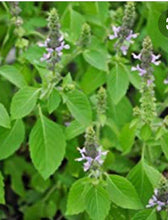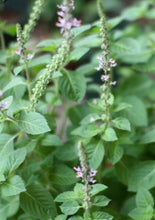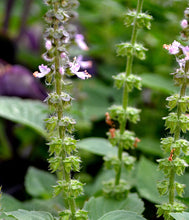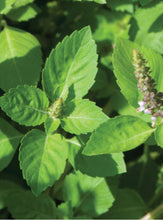Holy Basil Seed - (Kapoor) Ocimum Sanctum
Regular price
$5.00
Sale
Ocimum Sanctum - Seeds
As a medicinal herb it is used to prevent colds and flu, and cleanse the respiratory system of infection. The oil is used as an antioxidant, relieving aches and pains. In India, Hindus grow Tulsi as a religious plant in their homes and temples and use its leaves in routine worship.
Sacred Holy Green Basil
Recent scientific studies suggest that both the Green and Red varieties of Holy Basil may aid in lowering blood pressure, helping liver functions and reducing the risks of diabetes.
In addition to being a sacred medicinal herb, this Basil is also a potent natural pest repellent and companion plant. The oils naturally repel mosquitoes and house flies, giving it another reason to keep this plant in and around your home. Please read Briscoe's Tips for more information on growing and using this versatil
Light requirements: Full sun is ideal, but plants can grow in part shade.
Planting: Space 8 to 18 inches apart, depending on type. (Read the stick tag that comes with the plant for specific spacing recommendations.)
Soil requirements: Plants grow best in rich, moist but well-drained soil with a pH of 6.0 to 7.0. Work organic matter into soil before planting to add fertility and improve moisture retention. In containers, use premium quality potting soil.
Water requirements: Keep soil consistently moist through the growing season. Add a mulch layer to slow water evaporation from soil. In containers, water whenever the top inch of soil is dry.
Frost-fighting plan: Basil is very frost-tender and damaged by temperatures below 40º F. Use a frost blanket to protect newly planted seedlings from late spring frosts or prolong the fall growing season.
Common issues: Pinch flower buds to keep plants from bolting. Once flowers form, leaf flavor changes. Pests to watch out for: aphids, slugs, Japanese beetles, and earwigs. Fungal diseases sometimes occur in humid climates, and root rot is common in poorly drained soil.
Growing tips: Pinch or prune basil plants as they grow to promote branching and bushiness. Never cut into the woody parts of a stem; plants won’t resprout.
Harvesting: Pick leaves at any point in the growing season. Choose individual leaves, or snip leafy stems to the length you desire.
Storage: Cut basil stems and place in water like a fresh bouquet. They’ll last for weeks, provided you remove any leaves below the water line and change water regularly. Never place basil in the refrigerator; the cold air damages leaves. Preserve basil by freezing or in herbal vinegars.








